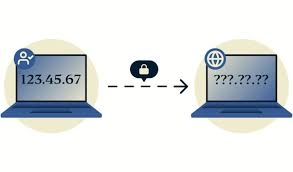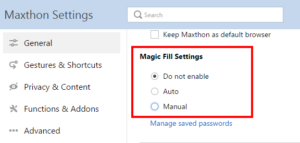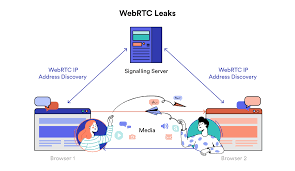In an age where digital privacy is increasingly under siege, your online presence might not be as anonymous as you think. Imagine browsing the web, believing yourself to be cloaked in a shield of anonymity, only to discover that every click and scroll could be revealing more about you than you’d ever intended. Websites today are equipped with sophisticated tools that can inadvertently—or deliberately—leak your actual IP address, siphon off intricate details about your device, and even create a unique fingerprint of your browser activity.

As we navigate this complex digital landscape, it’s crucial to understand how these processes work and the potential risks they pose to our personal information. From targeted ads that seem eerily tailored to your interests to security vulnerabilities that expose sensitive data, the information collected by websites can lead down a slippery slope of privacy invasion. In this article, we’ll explore the mechanisms behind these practices and provide actionable steps for safeguarding your online identity. By empowering yourself with knowledge about these hidden dangers, you can take proactive measures to protect what matters most: your privacy in an interconnected world.
IP address
IP address privacy tools are essential for understanding how your online identity might be exposed. These tools can reveal your IP address, a unique identifier that connected devices use to communicate over the Internet.

One key feature of these tools is reverse IP lookup, which allows users to see what other domain names share the same IP address. Additionally, HTTP request headers can provide insight into your location, showcasing details like your country, state, city, and Internet Service Provider (ISP).
These instruments often include real-time information such as your local time and Autonomous System Number (ASN), further enriching the profile they generate.
Moreover, an IP whois lookup feature helps users identify the registered owner of an IP address and their contact details. TCP/IP fingerprinting can determine which operating system you’re using based on network behaviour.

The tools also check for vulnerabilities like WebRTC leaks, DNS leaks, and potential issues with IPv6 configurations—all vital for maintaining security in online activities. Overall, these comprehensive features work together to paint a clearer picture of one’s digital footprint and help users manage their online privacy effectively.
Content Filters
This page features advanced detectors designed to identify the presence and usage of content filters. These filters are critical tools that modify the interaction between a web browser and the websites it visits.

Examples of popular content filters include the Tor Browser, which anonymises web traffic to protect user privacy, and AdBlockers, which prevent intrusive advertisements from appearing on web pages.
These detectors can effectively recognise when content filtering is in effect by analysing network traffic and connection patterns. The use of such filters can significantly enhance the browsing experience by reducing distractions and increasing privacy.
Understanding how these content filters operate helps users make informed decisions about their online activities. It also allows developers to optimise website performance while respecting user preferences for a clutter-free experience.
This page serves as a valuable resource for casual internet users and tech enthusiasts who want to learn more about how content-filtering technologies impact web interactions.
JavaScript
By leveraging JavaScript’s fundamental capabilities along with contemporary Web APIs, developers can uncover a vast amount of information about a user’s system.
One key piece of data is the User-Agent string, which provides insights into the browser type and version and the operating system being used.

Screen resolution is another crucial detail that can be obtained; this helps in understanding how to optimise content for different devices and displays.
Additionally, JavaScript allows access to the system’s language settings, enabling localisation features that cater to users’ preferred languages.
Local time information can also be gathered, offering time-zone awareness for scheduling and time-sensitive applications.
Moreover, developers can obtain specifications about the device’s CPU architecture and the number of logical cores available. This data encourages better performance optimisation by tailoring resource-intensive tasks accordingly.
Battery status is yet another aspect that can be monitored, allowing apps to adjust functionality based on battery life.
Network information such as connection type (Wi-Fi or mobile) and online/offline status provides critical context for apps reliant on internet connectivity.
Lastly, details about installed plugins can inform developers which additional functionalities are available to enhance user experiences further.
SSL/TLS Client Test
The SSL/TLS Client Test is a comprehensive tool designed to analyse your browser’s capabilities regarding secure communication protocols. By conducting this test, you can determine which Transport Layer Security (TLS) protocols your browser supports and the cypher suites it can use to encrypt data during transmission.
Additionally, this test evaluates TLS extensions and key exchange groups that play a critical role in establishing robust connections. Understanding these elements helps identify any weak or insecure configurations present in your browser.
One unique feature of the SSL/TLS Client Test is its ability to generate a JA3 fingerprint, which allows for the identification of specific client configurations and behaviours. This fingerprint can be invaluable for network security analysis and threat detection.

Furthermore, the tool examines how well your browser handles insecure mixed content—where both secure (HTTPS) and non-secure (HTTP) resources are loaded together on a web page. Identifying vulnerabilities related to mixed content can enhance your overall online safety and help you make informed decisions about browser settings and usage practices.
Canvas Fingerprinting
Canvas Fingerprinting is a sophisticated tracking technique that utilises HTML5 Canvas code to create a distinct identifier for each user who visits a website. This method capitalises on the unique way different devices and browsers render graphics, which results in slight variations in pixel output.
When a webpage employs the Canvas API, it generates an image or graphic element. The rendering process subtly differs from one device or browser to another due to variations in hardware, software settings, and display configurations. These differences result in a unique fingerprint that can be captured and stored by websites.
Once this fingerprint is established, web owners can track users across various browsing sessions and even after they have cleared their cookies. Unlike traditional cookies, which can be quickly deleted or blocked, Canvas fingerprints are more challenging for users to recognise and eliminate.
As privacy concerns grow, many people need to be made aware of how prevalent such techniques are in online tracking. Consequently, understanding the mechanics behind Canvas Fingerprinting helps shed light on broader discussions about digital privacy and user consent in today’s internet landscape.
Features Detection
The Web Browser’s Features Detection tool offers a comprehensive overview of available HTML5 feature detectors. These detectors are essential for understanding your browser’s capabilities and limitations regarding modern web technologies.

This tool allows you to identify which specific HTML5 features your browser supports, such as audio playback, advanced graphics rendering, or local storage. This information is crucial for developers who want to ensure their applications function seamlessly across various platforms.
Additionally, the tool helps you identify unsupported features, allowing you to make informed decisions about fallback options or alternative solutions. Understanding these aspects can significantly enhance user experience by ensuring accessibility and functionality.
Moreover, modifying certain browser settings related to these features may influence your digital footprint. Awareness of how feature detection impacts privacy and security is vital in today’s online environment. Overall, the Features Detection tool serves as a valuable resource for developers and end-users alike.
WebRTC Leak Test
The WebRTC Leak Test is an essential tool for anyone utilising a Virtual Private Network (VPN). It takes advantage of the WebRTC API, which is designed for real-time communication between browsers and devices.

When a user connects to the Internet through a VPN, their public IP address should be masked for anonymity. However, the WebRTC protocol can sometimes bypass this protection by establishing connections with STUN (Session Traversal Utilities for NAT) servers.
These servers can unintentionally reveal a user’s accurate local and public IP addresses. This leakage poses a significant privacy risk, as it undermines the very purpose of using a VPN or proxy server.
By using the WebRTC Leak Test, individuals can quickly determine if their actual public IP is exposed while connected to a VPN. The results provide clarity on whether additional steps are required to enhance online security.
Regular testing with this tool helps ensure that users maintain their privacy in an increasingly digital world. It’s an essential safeguard against unexpected information disclosure during web browsing activities.
Geolocation API
The Geolocation API is a powerful feature that enables websites to access precise geographical location data from users’ devices. This technology can determine a user’s position using various sources, including GPS, Wi-Fi signals, and cell tower triangulation.
With the HTML5 Geolocation API testing tool, developers can analyse how well their websites interact with this feature. The tool provides insights into the accuracy of location data retrieved during tests.  . Additionally, it helps identify whether the necessary browser permissions are correctly configured to allow location access.
. Additionally, it helps identify whether the necessary browser permissions are correctly configured to allow location access.
Understanding these parameters is crucial for creating applications that rely on location-based services. By effectively leveraging this API, businesses can enhance user experience through personalised content and targeted features. Overall, the Geolocation API is instrumental in bridging digital interactions with real-world locations.
WebGL Report
The WebGL Report is an essential diagnostic tool designed to assess and analyse your web browser’s WebGL capabilities. It provides insights into how well your browser supports WebGL, a JavaScript API that allows for rendering 3D graphics within any compatible web page.
One of the standout features of the WebGL Report is its ability to generate a unique WebGL fingerprint. This fingerprint can identify your specific browser and configuration among countless others on the internet.
The report reveals detailed information about your graphics processing unit (GPU), including its make and model, performance specifications, and driver version. Additionally, it highlights various WebGL features supported by your browser, such as texture formats and the extent of shader language support.
In this way, the tool not only enables users to understand their system’s graphics capabilities but also sheds light on potential privacy concerns. Since this information can distinguish one user’s setup from another, it has implications for online tracking and personalisation.
Ultimately, the WebGL Report serves as a valuable resource for web developers seeking to optimise graphical content for users while also providing users with a better understanding of their browsing environment.
Font fingerprinting
Font fingerprinting is an innovative tracking technique employed by websites to monitor user activity in a way that is often subtle and unnoticed. This method leverages the unique properties of the fonts installed on a user’s device, including their sizes, styles, and specific characteristics.

By examining how these fonts render in different contexts, researchers can identify slight variations in glyph dimensions and spacing. Each user’s font collection typically has distinctive attributes, making it possible to create a digital fingerprint that represents their system.
The process involves analysing not just the types of fonts available but also how they are rendered by the device’s operating system and browser. Numerous factors, including screen resolution and type settings, can influence these rendering differences.
Because many users do not frequently alter their font selections or settings, this fingerprint remains largely stable over time. Consequently, deleting cookies or using incognito modes does little to prevent tracking via font fingerprinting.
Overall, due to its complexity and uniqueness, font fingerprinting presents a significant challenge for those looking to maintain online anonymity. As awareness of this technique grows, users may seek out additional tools or methods to protect their digital privacy more effectively.
Maxthon privacy
Maxthon’s private browsing feature allows users to explore the internet without their actions being recorded or saved. Often referred to as incognito mode, this functionality prevents the browser from storing cookies, history, and other data on your device.
By utilising private browsing, individuals can better protect their privacy and avoid leaving a digital footprint of their online activities. However, it’s essential to understand that while this feature enhances privacy, it does not ensure complete security.
For instance, if you’re using a work computer, your employer may still have the ability to monitor your internet usage. Similarly, your internet service provider can track the websites you visit and any files you download.
Moreover, private browsing offers limited protection against government surveillance or hackers—especially when connecting through public Wi-Fi networks. Therefore, while Maxthon’s private browsing is a convenient option for safeguarding personal information, users should remain aware of its limitations in ensuring total anonymity online.
